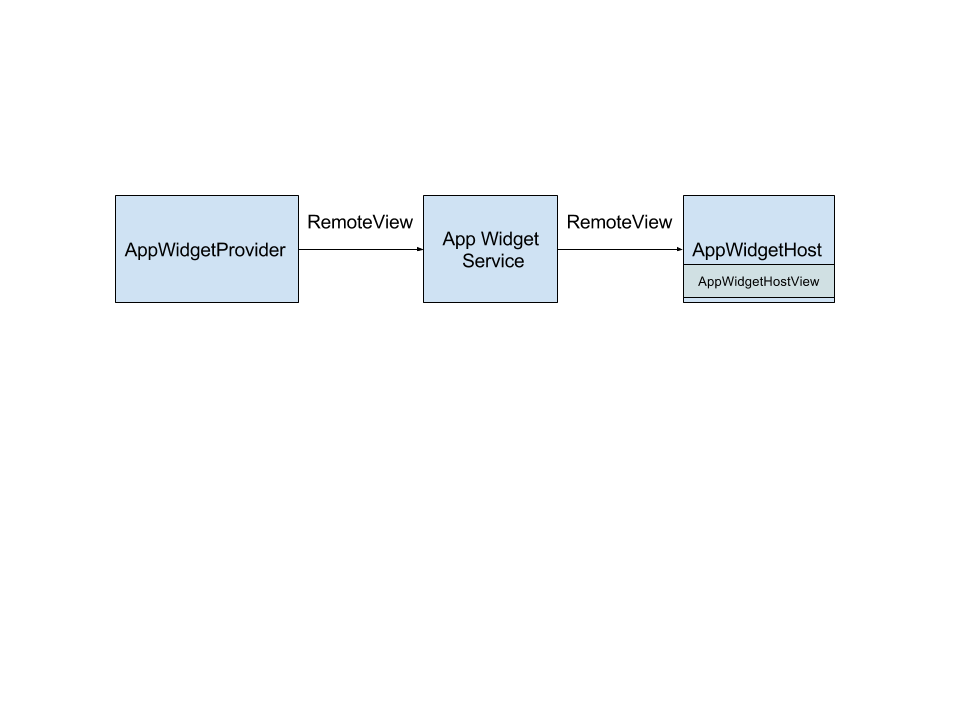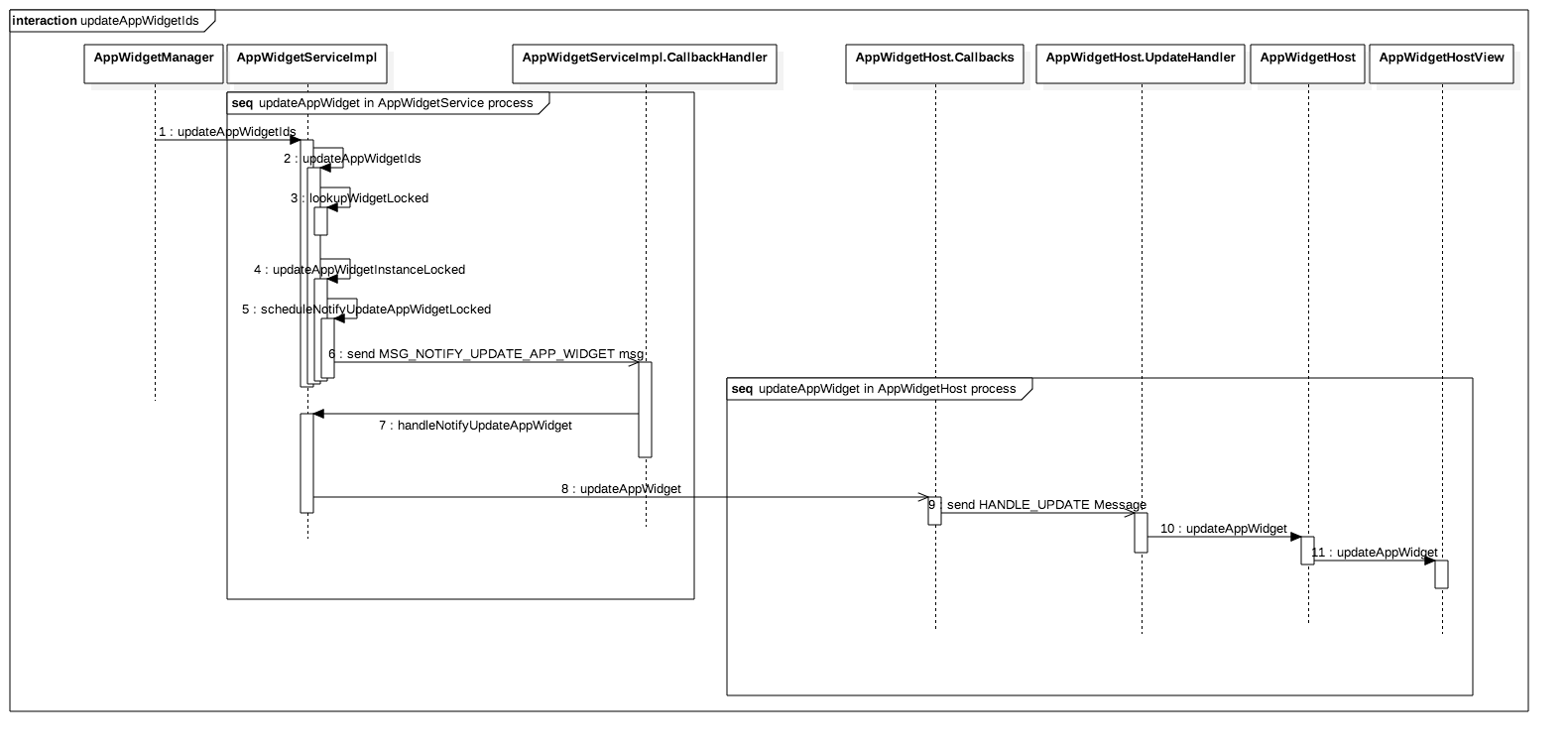編輯:關於Android編程
前面一篇文章,分析了AppWidgetProvider和RemoteView的源碼,從中我們可以知道它們的實現原理,AppWidgetProvider是一個BroadcastReceiver,所以它是通過廣播接收通知的,收到更新通知後,AppWidgetProvider需要去提供View供遠程進程顯示,而提供的View則是使用RemoteView來代替,通過RemoteView(是一個Parcelable,可跨進程傳輸數據類型)來作為媒介去傳遞給遠程進程。由遠程進程解析RemoteView,然後顯示RemoteView表示的真正的View。在這篇文章將分析這個傳輸過程。
還是先看一下上一篇給出的一個過程圖示:

實際上,AppWidgetProvider是通過AppWidgetManager來更新View的,而AppWidgetManager裡面是有一個IAppWidgetService,一看就知道這是一個idle生成的,是一個Binder通信。而服務端的AppWidgetService是AppWidgetServiceImpl,AppWidgetServiceImpl又會通過一個IAppWidgetHost來跨進程通知AppWidgetHZ喎?/kf/ware/vc/" target="_blank" class="keylink">vc3SjrEFwcFdpZGdldEhvc3TE2rK/tcRJQXBwV2lkZ2V0SG9zdMrHQXBwV2lkZ2V0SG9zdC5DYWxsYmFja6Gj1eLR+b7Ntb3By8/Uyr7O0sPHtcRBcHBXaWRnZXS1xL34s8yjqLTzsr+31srHTGF1bmNoZXLTptPDo6mhozwvcD4NCjxwPrfWx+Wz/sO/uPayv7fWysfU2sqyw7S9+LPM1MvQ0LXEttTT2sDtveLV+7j2wfezzMrHt8ezo9PQsO/W+rXEo6xBcHBXaWRnZXRQcm92aWRlcsrH1NrO0sPH19S8urXE06bTw7PM0PK9+LPMtbHW0KOstvhBcHBXaWRnZXRTZXJ2aWNlysfUy9DQ1NpTeXN0ZW1TZXJ2ZXK9+LPMo6xBcHBXaWRnZXRIb3N01PLKx9TL0NDU2s/Uyr5BcHBXaWRnZXS1xL34s8zW0KOsscjI50xhdW5jaGVy06bTw6Oo18DD5qOpoaPV+7j2wfezzM/gtbHT2srHv+fUvcHLyP249r34s8yhozwvcD4NCjxoMiBpZD0="updateappwidgetids過程分析">updateAppWidgetIds過程分析
這是AppWidgetManager的一個接口函數,根據id來更新AppWidget。先把整個更新過程的時序圖拿出來看一下:

從我們普通的調用AppWidgetManager的updateAppWidget看起吧:
appWidgetManager.updateAppWidget(appwidgetids,remoteViews);
這裡進入updateAppWidget方法:
public void updateAppWidget(int[] appWidgetIds, RemoteViews views) {
if (mService == null) {
return;
}
try {
mService.updateAppWidgetIds(mPackageName, appWidgetIds, views);
}
catch (RemoteException e) {
throw new RuntimeException("system server dead?", e);
}
}
mService是一個IAppWidgetService類型,初始化是在SystemServiceRegistry(6.0才出現的,之前在ContextImpl裡面)裡面:
registerService(Context.APPWIDGET_SERVICE, AppWidgetManager.class,
new CachedServiceFetcher() {
@Override
public AppWidgetManager createService(ContextImpl ctx) {
IBinder b = ServiceManager.getService(Context.APPWIDGET_SERVICE);
return new AppWidgetManager(ctx, IAppWidgetService.Stub.asInterface(b));
}});
注冊服務的時候獲取APPWIDGET_SERVICE。所以mService.updateAppWidgetIds最後會調用到遠程進程,而IAppWidgetService的實現者是AppWidgetServiceImpl,所以最終會調用AppWidgetServiceImpl的updateAppWidgetIds。
AppWidgetServiceImpl中的updateAppWidgetIds:
@Override
public void updateAppWidgetIds(String callingPackage, int[] appWidgetIds,
RemoteViews views) {
if (DEBUG) {
Slog.i(TAG, "updateAppWidgetIds() " + UserHandle.getCallingUserId());
}
updateAppWidgetIds(callingPackage, appWidgetIds, views, false);
}
這就是AppWidgetServiceImpl的updateAppWidgetIds方法。程序已經開始進入到AppWidgetServiceImpl所在的進程了,實際上是SystemServer進程。怎麼看出AppWidgetServiceImpl是運行在SystemServer進程呢?AppWidgetService類new了一個AppWidgetServiceImpl,並且注冊到ServiceManager中:
public class AppWidgetService extends SystemService {
private final AppWidgetServiceImpl mImpl;
public AppWidgetService(Context context) {
super(context);
mImpl = new AppWidgetServiceImpl(context);
}
@Override
public void onStart() {
publishBinderService(Context.APPWIDGET_SERVICE, mImpl); //注冊mImpl到ServiceManager當中
AppWidgetBackupBridge.register(mImpl);
}
@Override
public void onBootPhase(int phase) {
if (phase == PHASE_THIRD_PARTY_APPS_CAN_START) {
mImpl.setSafeMode(isSafeMode());
}
}
}
而AppWidgetService在SystemServer.java中使用:
private static final String APPWIDGET_SERVICE_CLASS =
"com.android.server.appwidget.AppWidgetService";
SystemServer是通過反射的方式new一個AppWidgetService對象,然後調用它的start函數。很多service類都是這樣啟動的。
回到updateAppWidgetIds方法,最後它會調用四個參數的updateAppWidgetIds方法:
private void updateAppWidgetIds(String callingPackage, int[] appWidgetIds,
RemoteViews views, boolean partially) {
final int userId = UserHandle.getCallingUserId();
if (appWidgetIds == null || appWidgetIds.length == 0) {
return;
}
// Make sure the package runs under the caller uid.
mSecurityPolicy.enforceCallFromPackage(callingPackage);
final int bitmapMemoryUsage = (views != null) ? views.estimateMemoryUsage() : 0;
if (bitmapMemoryUsage > mMaxWidgetBitmapMemory) {
throw new IllegalArgumentException("RemoteViews for widget update exceeds"
+ " maximum bitmap memory usage (used: " + bitmapMemoryUsage
+ ", max: " + mMaxWidgetBitmapMemory + ")");
}
synchronized (mLock) {
ensureGroupStateLoadedLocked(userId);
final int N = appWidgetIds.length;
for (int i = 0; i < N; i++) {
final int appWidgetId = appWidgetIds[i];
// NOTE: The lookup is enforcing security across users by making
// sure the caller can only access widgets it hosts or provides.
Widget widget = lookupWidgetLocked(appWidgetId,
Binder.getCallingUid(), callingPackage);
if (widget != null) {
updateAppWidgetInstanceLocked(widget, views, partially);
}
}
}
}
該方法首先會做些安全性檢查,以及圖片大小限制檢查。最後會針對每一個appWidgetId,通過lookupWidgetLocked找到其對應的Widget。
Widget是一個帶有很多信息的類,我們看看lookupWidgetLocked方法:
private Widget lookupWidgetLocked(int appWidgetId, int uid, String packageName) {
final int N = mWidgets.size();
for (int i = 0; i < N; i++) {
Widget widget = mWidgets.get(i);
if (widget.appWidgetId == appWidgetId
&& mSecurityPolicy.canAccessAppWidget(widget, uid, packageName)) {
return widget;
}
}
return null;
}
實際上它是從mWidgets找到對應的Widget,先看看Widget類,它是AppWidgetServiceImpl的非靜態內部類:
private static final class Widget {
int appWidgetId;
int restoredId; // tracking & remapping any restored state
Provider provider; // 對應AppWidgetProvider,裡面有AppWidgetProvider信息。
RemoteViews views; //表示View的RemoteView
Bundle options;
Host host; //顯示的地方
@Override
public String toString() {
return "AppWidgetId{" + appWidgetId + ':' + host + ':' + provider + '}';
}
}
而是從什麼時候把Widget添加到mWidgets的呢?主要有三個地方,一個是綁定AppWidgetProvider跟id時,初始化時加載AppWidget與對應的host;一個是第一次添加AppWidget到桌面時,給AppWidget分配id的時候;一個是restore AppWidget的時候。我們看看分配id時,添加Widget的代碼:
@Override
public int allocateAppWidgetId(String callingPackage, int hostId) {
final int userId = UserHandle.getCallingUserId();
// Make sure the package runs under the caller uid.
mSecurityPolicy.enforceCallFromPackage(callingPackage);
synchronized (mLock) {
ensureGroupStateLoadedLocked(userId);
if (mNextAppWidgetIds.indexOfKey(userId) < 0) {
mNextAppWidgetIds.put(userId, AppWidgetManager.INVALID_APPWIDGET_ID + 1);
}
final int appWidgetId = incrementAndGetAppWidgetIdLocked(userId); //增量分配一個id,保證不沖突
// NOTE: The lookup is enforcing security across users by making
// sure the caller can only access hosts it owns.
HostId id = new HostId(Binder.getCallingUid(), hostId, callingPackage); //得到hostid
Host host = lookupOrAddHostLocked(id); //根據id獲取host
Widget widget = new Widget();
widget.appWidgetId = appWidgetId;
widget.host = host;
host.widgets.add(widget); //把widget添加到host的widgets列表中
addWidgetLocked(widget); //添加
saveGroupStateAsync(userId);
return appWidgetId;
}
}
實際上這裡還沒有添加對應的provider,所以在Launcher開發的時候,我們需要先調用allocateAppWidgetId方法,然後調用bindAppWidgetId方法綁定id與AppWidgetProvider。而當View有變化的時候,Host需要接收AppWidgetServiceImpl的通知,如何實現的呢?Host(Launcher應用)會跨進程調用AppWidgetServiceImpl的startListening方法,將AppWidgetHost端的Callback服務傳遞給AppWidgetServiceImpl:
// 在AppWidgetHost類當中,AppWidgetHost是Host端的代碼
public void startListening() {
int[] updatedIds;
ArrayList updatedViews = new ArrayList();
try {
updatedIds = sService.startListening(mCallbacks, mContextOpPackageName, mHostId,
updatedViews); //把AppWidgetHost端的mCallbacks傳遞給AppWidgetService,mCallbacks是Binder對象。
}
catch (RemoteException e) {
throw new RuntimeException("system server dead?", e);
}
final int N = updatedIds.length;
for (int i = 0; i < N; i++) {
updateAppWidgetView(updatedIds[i], updatedViews.get(i));
}
}
在AppWidgetServiceImpl裡面會將mCallbacks保存在對應的Host當中。
從mWidgets裡面找到Widget後,會調用updateAppWidgetInstanceLocked方法來更新Widget。
private void updateAppWidgetInstanceLocked(Widget widget, RemoteViews views,
boolean isPartialUpdate) {
if (widget != null && widget.provider != null
&& !widget.provider.zombie && !widget.host.zombie) { // 保證widget有效,並且host也有效
if (isPartialUpdate && widget.views != null) {
// For a partial update, we merge the new RemoteViews with the old. 這裡是對於partial update的。
widget.views.mergeRemoteViews(views);
} else {
// For a full update we replace the RemoteViews completely.
widget.views = views;
}
scheduleNotifyUpdateAppWidgetLocked(widget, views);
}
}
而scheduleNotifyUpdateAppWidgetLocked 則是使用handler發送一個消息給主線程處理:
private void scheduleNotifyUpdateAppWidgetLocked(Widget widget, RemoteViews updateViews) {
if (widget == null || widget.provider == null || widget.provider.zombie
|| widget.host.callbacks == null || widget.host.zombie) {
return;
}
SomeArgs args = SomeArgs.obtain();
args.arg1 = widget.host;
args.arg2 = widget.host.callbacks; //callbacks 是host的跨進程調用接口,來自於startListening
args.arg3 = updateViews;
args.argi1 = widget.appWidgetId;
mCallbackHandler.obtainMessage(
CallbackHandler.MSG_NOTIFY_UPDATE_APP_WIDGET,
args).sendToTarget();
}
使用mCallbackHandler發送一條MSG_NOTIFY_UPDATE_APP_WIDGET的消息,mCallbackHandler是AppWidgetServiceImpl.CallbackHandler的實例。如果處理,具體就到CallbackHandler的handleMessage方法中,就是一個Handler機制,讓代碼運行在主線程:
@Override
public void handleMessage(Message message) {
switch (message.what) {
case MSG_NOTIFY_UPDATE_APP_WIDGET: {
SomeArgs args = (SomeArgs) message.obj;
Host host = (Host) args.arg1;
IAppWidgetHost callbacks = (IAppWidgetHost) args.arg2;
RemoteViews views = (RemoteViews) args.arg3;
final int appWidgetId = args.argi1;
args.recycle();
handleNotifyUpdateAppWidget(host, callbacks, appWidgetId, views);
} break;
...
}
}
handleNotifyUpdateAppWidget方法:
private void handleNotifyUpdateAppWidget(Host host, IAppWidgetHost callbacks,
int appWidgetId, RemoteViews views) {
try {
callbacks.updateAppWidget(appWidgetId, views); //通知AppWidgtHost
} catch (RemoteException re) {
synchronized (mLock) {
Slog.e(TAG, "Widget host dead: " + host.id, re);
host.callbacks = null;
}
}
}
這裡實際上就是調用IAppWidgetHost類型的updateAppWidget,進行跨進程調用。而callbacks就是在AppWidgetServiceImpl的startListening設置的:
@Override
public int[] startListening(IAppWidgetHost callbacks, String callingPackage,
int hostId, List updatedViews) {
final int userId = UserHandle.getCallingUserId();
if (DEBUG) {
Slog.i(TAG, "startListening() " + userId);
}
// Make sure the package runs under the caller uid.
mSecurityPolicy.enforceCallFromPackage(callingPackage);
synchronized (mLock) {
ensureGroupStateLoadedLocked(userId);
// NOTE: The lookup is enforcing security across users by making
// sure the caller can only access hosts it owns.
HostId id = new HostId(Binder.getCallingUid(), hostId, callingPackage);
Host host = lookupOrAddHostLocked(id);
host.callbacks = callbacks; //設置callbacks
updatedViews.clear();
ArrayList instances = host.widgets;
int N = instances.size();
int[] updatedIds = new int[N];
for (int i = 0; i < N; i++) {
Widget widget = instances.get(i);
updatedIds[i] = widget.appWidgetId;
updatedViews.add(cloneIfLocalBinder(widget.views));
}
return updatedIds;
}
}
最終updateAppWidget的實現代碼是:
static class Callbacks extends IAppWidgetHost.Stub {
private final WeakReference mWeakHandler;
public Callbacks(Handler handler) {
mWeakHandler = new WeakReference<>(handler);
}
public void updateAppWidget(int appWidgetId, RemoteViews views) {
if (isLocalBinder() && views != null) {
views = views.clone();
}
Handler handler = mWeakHandler.get();
if (handler == null) {
return;
}
Message msg = handler.obtainMessage(HANDLE_UPDATE, appWidgetId, 0, views);
msg.sendToTarget();
}
}
最後使用Handler發送消息給主線程,然後在handleMessage中有具體的處理程序:
class UpdateHandler extends Handler {
public UpdateHandler(Looper looper) {
super(looper);
}
public void handleMessage(Message msg) {
switch (msg.what) {
case HANDLE_UPDATE: {
updateAppWidgetView(msg.arg1, (RemoteViews)msg.obj);
break;
}
}
}
}
然後調用AppWidgetHost的updateAppWidgetView方法:
void updateAppWidgetView(int appWidgetId, RemoteViews views) {
AppWidgetHostView v;
synchronized (mViews) {
v = mViews.get(appWidgetId);
}
if (v != null) {
v.updateAppWidget(views);
}
}
根據appWidgetId找到對應的AppWidgetHostView,然後調用AppWidgetHostView的updateAppWidget來根據RemoteView來更新AppWidgetHostView:
/**
* Process a set of {@link RemoteViews} coming in as an update from the
* AppWidget provider. Will animate into these new views as needed
*/
public void updateAppWidget(RemoteViews remoteViews) {
boolean recycled = false;
View content = null;
Exception exception = null;
// Capture the old view into a bitmap so we can do the crossfade.
... 省去old view to bitmap
if (remoteViews == null) {
if (mViewMode == VIEW_MODE_DEFAULT) {
// We've already done this -- nothing to do.
return;
}
content = getDefaultView(); // 默認的View
mLayoutId = -1;
mViewMode = VIEW_MODE_DEFAULT;
} else {
// Prepare a local reference to the remote Context so we're ready to
// inflate any requested LayoutParams.
mRemoteContext = getRemoteContext();
int layoutId = remoteViews.getLayoutId();
// If our stale view has been prepared to match active, and the new
// layout matches, try recycling it
if (content == null && layoutId == mLayoutId) {
try {
remoteViews.reapply(mContext, mView, mOnClickHandler);
content = mView;
recycled = true;
if (LOGD) Log.d(TAG, "was able to recycled existing layout");
} catch (RuntimeException e) {
exception = e;
}
}
// Try normal RemoteView inflation
if (content == null) {
try {
content = remoteViews.apply(mContext, this, mOnClickHandler);
if (LOGD) Log.d(TAG, "had to inflate new layout");
} catch (RuntimeException e) {
exception = e;
}
}
mLayoutId = layoutId;
mViewMode = VIEW_MODE_CONTENT;
}
if (content == null) {
if (mViewMode == VIEW_MODE_ERROR) {
// We've already done this -- nothing to do.
return ;
}
Log.w(TAG, "updateAppWidget couldn't find any view, using error view", exception);
content = getErrorView(); // 在失敗的情況下,會使用ErrorView。
mViewMode = VIEW_MODE_ERROR;
}
if (!recycled) {
prepareView(content);
addView(content);
}
if (mView != content) {
removeView(mView);
mView = content;
}
if (CROSSFADE) {
if (mFadeStartTime < 0) {
// if there is already an animation in progress, don't do anything --
// the new view will pop in on top of the old one during the cross fade,
// and that looks okay.
mFadeStartTime = SystemClock.uptimeMillis();
invalidate();
}
}
}
代碼有點長,但我覺得值得認真一看,可以從源碼中發現當我們的AppWidget在桌面顯示異常時究竟可能是什麼原因。更新view的整個策略主要就是:
如果remoteView為空,則看是否已經使用了默認視圖,如果已經使用了直接返回,如果沒有則使用默認的視圖。
如果remoteView不為空,則看layoutid是否跟現在已經使用的視圖的layoutid一致,一致則重用舊的視圖,調用remoteView.reapply方法重用視圖,並且設置視圖內容。
如果layoutid跟現使用的視圖不一致,則調用remoteView.apply方法得到新的視圖。
如果上面的步驟都沒有得到視圖,則使用錯誤視圖。
如果新的視圖與舊的視圖不一致,則添加新的視圖,刪除舊的視圖。
其實這裡更新視圖的策略非常簡單,盡量重用已有的視圖。裡面會有三種視圖,一種是我們自己設置的,一種是默認的,一種是有錯誤的情況的。當我們在桌面上看到我們的AppWidget顯示異常時,應該還是有兩種不同的表現的,一種是錯誤情況,一種是是用來額默認的視圖,如果remoteView為null的時候會使用默認視圖,如果是從remoteView中讀取視圖失敗時,則會使用錯誤視圖。
所以看到錯誤視圖時,我們可能需要考慮remoteView裡面的View設置是否合理。如果看到的是默認視圖,我們應該想想是否在AppWidgetProvider中調用了AppWidgetManager.updateAppWidget方法,是否remoteView參數為null?可能有的手機兩種視圖是一樣的。
總結整個updateAppWidget的分析就到這裡了,AppWidget其他的更新也是一樣的,整個更新過程跨越了三個進程,而RemoteView作為一種View跨進程傳遞的媒介。另外我覺得從AppWidget去理解Binder機制的使用可能也是一個非常好的切入點。因為這部分我們在應用開發當中經常使用,而且是View,能夠看到效果。接下來我想寫一篇關於Binder多線程的理解。我看AppWidget這部分的源碼,也是項目中的AppWidget存在問題,熟悉AppWidget才能解決好問題,預測代碼中可能潛在的問題。
 Android Design之Android4.0不一樣的裡程碑
Android Design之Android4.0不一樣的裡程碑
想成為Android的傑出開發工程師,不懂得Android的設計規則怎麼可以,Android4.0問世後谷歌公司為Android程序員規范了一系列的設計原則,不要再盲目的
 Android提高之SQLite分頁讀取實現方法
Android提高之SQLite分頁讀取實現方法
一般來說,Android自身就包含了常用於嵌入式系統的SQLite,這樣就免去了開發者自己移植安裝的功夫。SQLite 支持多數SQL92標准,很多常用的SQL命令都能在
 《Android源碼設計模式解析與實戰》讀書筆記(二十一)
《Android源碼設計模式解析與實戰》讀書筆記(二十一)
第二十一章、裝飾模式 裝飾模式也稱為包裝模式,是結構型設計模式之一。裝飾模式是一種用於替代繼承技術的一種方案。1.定義動態的給一個對象添加一些額外的職責。就增加功能來說,
 android的屬性動畫
android的屬性動畫
前言屬性動畫(Property Animation)系統是一個更加強大的框架,它幾乎允許你為任何東西設置動畫。不管一個對象是否需要繪制到屏幕上面,你都可以定義一個動畫讓這